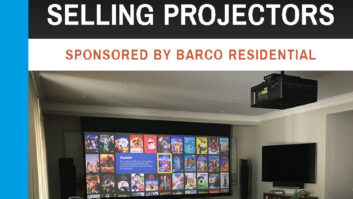
Ira Friedman is the CEO of Bay Audio, a manufacturer of custom speaker solutions. He holds an MBA from the Harvard Business School. There’s so much fuss over the subject of the high-end customer. I argue that the most logical path for an integration company is pursuing “high net worth” individuals, which I wrote about in my last column [RS, June 2013]. Here’s why: There are four disciplines every integrator offers his clients: design, engineering, programming, and project management. Every job–from a simple $20,000 multi-room audio system, to the most complex–requires effort in these four disciplines. And every integrator, regardless of size and experience, offers these four disciplines.
In its simplest form, the multi-room audio system requires all four. Design, because electronics and speakers have to be located. Engineering, to determine wiring and interconnectivity. Programming, albeit as simple as flipping a few switches and directing some code. And project management, which is self-evident.
These four disciplines, in essence, define the integration process. This leads to the inevitable truth that integrators compete with each other based on their expertise in the four disciplines, with the best integrators excelling in all four. It’s these four disciplines–and only these four disciplines–that distinguish one integrator from the next. Not product. Not the number of vans. Not location.
Intellectual Property Matters
The systems that an integrator employs to enhance their four disciplines becomes the intellectual property of the company. It’s the magic that makes one integration firm stand out from the others.
Great integrators are not made by great products. Great companies use great products, and they use them well, but only to deliver on the promise of their design, engineering, and programming.

Large projects, sold to wealthy clients, include fees for design, engineering, programming, and project management. These clients pay these fees, and these integrators earn a living for their intellectual property. Which brings us to the naysayers that feel they can build a respectable long-term business around mid-priced systems sold to everyday clients.
By their very nature, everyday clients don’t put much value in design, engineering, programming, and project management. Which is why most proposals to these clients undervalue, or simply ignore these elements. How many $20,000 multi-room system proposals have a line item for design, engineering, or even project management? Very few. Clients at this level are hyper-focused on the gear and the price of each component. Trying to justify a project management fee is simply too difficult, so it’s left off the proposal.
And, of course, it’s left out of the budget. Which boggles the mind. When I ask an everyday integrator if they do design or engineering, I’m always told “yes.” But when I ask if they charge for it, they say, “not really, because my clients don’t want to pay for it.”
I’ll let you in on a little secret. Clients don’t want to pay for anything.
But as we established earlier, every job gets design, and engineering, and programming, and project management. But lower priced jobs don’t include these fees. Meaning, the integrator is not getting paid for the very thing he uses to distinguish himself in the market.
Only High-End Projects Can Support This Business
Large projects, sold to wealthy clients, include fees for the four disciplines. And these clients pay these fees. And these integrators earn a living for their intellectual property. That’s a real business.
Integrators chasing the everyday client often discount their offerings. Sure, maybe they sell products at MSRP, but without charging an appropriate amount for the four disciplines, they weigh their proposals heavily toward product and away from labor. The typical high-end integrator invoices at least 35 percent of each project as labor. The everyday integrator is closer to 25 percent because he’s not charging for the four disciplines–the very thing that makes him an integrator and not a freelance installer.
So, if there’s a group of dealers out there that find it comforting to play in the middle of the market, I say, “bully for you.” You’ve established a strategy of healthy discounting that has kept you alive. You discount labor.
Discounting strategies are certainly valid–look at Costco and Walmart. But a successful discounting strategy relies on volume. Unless you’re selling $20,000 multi-zone systems daily, you’re not in a mass market. Indeed, the integration market is a low-volume market. There are no successful discounters in a low-volume market. Ever. Instead, these discounters simply disrupt the market because they don’t charge enough to fully support their intellectual property.
Oh, the feathers are ruffled, I’m sure. But if you find yourself forging ahead with your middle-of-the-road discounting strategy, just ask yourself this question: If you could replace 10 $20,000 projects with one $200,000 project, wouldn’t you? Of course you would–because inherently, you know this is a better client, a better project, and an opportunity to flex your intellectual muscle and compete on your innate capabilities.







